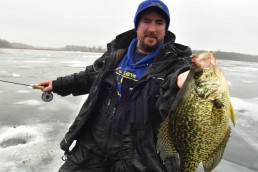Tips from Norway
SHARE THIS POST
A few years back, I was speaking with a couple I knew after a church service. It was early winter and on the church property there were a couple of ponds within view out of the windows of the narthex. Typical angler—as we were talking I was checking out the almost frozen ponds over the couples’ shoulders.
When the conversation slowed a bit, I mentioned how I couldn’t wait for good ice. Surprisingly, the woman, and not the man, voiced how much she missed ice fishing.
Now before anybody gets mad and sends me an email, I’m not shocked that a woman would be into ice fishing, as there are plenty of excellent ice fishing ladies out there. But I just never figured this particular woman to be a fellow hard-water enthusiast.
I found out Hannah was born and raised in Norway and that her father was an accomplished and rather well known ice fishing angler over there. As she got a little older, he began taking her on his ice outings.
We began swapping ice fishing stories, tactics and techniques, and all the differences between European ice fishing and the sport in North America. Her husband, who was not an angler, lost interest in our talk and headed for a more fitting conversation with others.
I was amazed at her knowledge of the sport and thought I might share a bit of her story. Hopefully, you might find a few bits of ice wisdom that might be put to use this season.
First, please realize that her father’s ice fishing tactics and days were from years ago. The equipment was very simple as were the techniques compared ice fishing of today, but we can still learn from lessons from the past. Sometimes with ice fishing and other types we can often make things so complex that part of the angling experience itself can become overwhelming, or sometimes even lost, especially to those new to the sport.
To be honest, I went out a few times and tried to duplicate his style of ice fishing by bare-boning my gear and reducing my multitude of techniques into just a couple simple approaches.
The result? They worked for him and they still work today for me.
Now, I’m certainly not advocating that anybody should leave their modern ice gear behind for this “new,” though old-world concept, but some of these simple approaches just might be the ticket for an angler desiring to give hard-water fishing a whirl. And you have to admit that some of the new advanced ice gear and techniques could be a little intimidating to a novice as well.
As I mentioned earlier, my friend Hannah’s father was a successful Norwegian angler on the ice, and so was she. I learned they both used very basic tackle, consisting of simple rods with some having no reels at all, a handful of homemade jigs, baits, and an ice spud, or chisel. The two bundled up and headed out on the ice with a whole lot of experience and knowledge about fish location and their behavior.
Hannah went on to explain that when they hit the ice in Norway, they pulled no shelter, there were no electronics or heaters used, not even a 5-gallon bucket many use here. Her dad carried his rods, a small amount of tackle, baits and other supplies all in a pack worn on his back. By hand, he carried his ice spud or chisel to make his holes. (Later years, he’d use an auger.) The two had no GPS, but relied on using three visual “landmark” points to find their favorite fishing areas.
She said once he found his spot he began to make his holes with the ice spud. If you have never seen one, it’s a 6-foot-long solid steel bar with a sharp, chiseled end. While this tool might sound prehistoric, if you ever had the chance to watch someone good with an ice spud open a hole, you’d be amazed.
Now with several holes completed, the fishing began.
Carrying about four rods per trip in his pack, he would pick out the already rigged rods. The rods themselves were different than our normal mini-sized spinning rods—some had an oversized, steel, reel wheel that held the line, some were just jigging sticks with just a line wrap on the handle to store the line and others were palm-sized fishing rods for very small gamefish.
Are you enjoying this post?
You can be among the first to get the latest info on where to go, what to use and how to use it!
He’d use a cloth-type line on the larger rods—I’m assuming was somewhat of a Dacron line—that was popular for muskies and pike years ago, a predecessor to our modern braids.
Before he dropped a baited jig he would “plumb” or check the depths with a lead weight attached to the jig. Once finding the bottom’s depth, he marked the depth by reeling in line with the tip close to the water’s surface or by hand winding and wrapping the line back on the line holder. This showed him where his was depth was at, by the amount of line extending beyond the rod tip. (Remember, there were no locators back then.)
Next was the part I guess I’ll always remember—probably because of the demonstration itself. While ice fishing, they never sat on buckets or benches in shelters, but actually knelt on the ice with the hole practically between their legs. With your back to the wind, this kept your line from moving by being blown about and was a bit warmer for the body. So, right there in the narthex of this church, Hannah knelt down on the floor, showing me the exact position her dad would use to catch his fish. While she’s still giving me this “seminar,” people seeing her on her knees began to congregate behind us, figuring this must be some serious prayer time going on!
I then felt a gentle hand on my shoulder as the Pastor checked to see if he could be of any assistance, but I assured him that this was just a fishin’ thing. He just shrugged and moved along.
From this “position,” her dad would start the presentation just under the ice and work his jig and bait down to the active fish, slowing at various intervals to locate the most active depth. Once found, he would sometimes reel or wind the excess line in to the correct depth on the rod then would be back at the correct depth on the next drop. He didn’t use floats, but he either ran the line through his fingers to feel the bite or would watch for line movement.
Sitting on the ice, you are so close to where the line enters the water you’d be amazed at how easily you can see a take or strike without any type of float or indicator, such as a spring device.
As far as bringing in a fish, it was all done by hand-lining the fish to the surface, pretty much the same way you would retrieve a fish when using a tip-up. I know some might not find the interest, but it is really a cool way to bring a fish back to the hole, and is an art form for sure.
Well, Hannah’s seminar lasted longer, but it really has very practical applications within the process that can work today. What I gained from Hannah’s story—which I will forever be grateful—was the simplicity of their successful outings on the ice.
I’ll be the first to to admit it: I love all the innovations in today’s ice fishing world as equipment keeps being refined and the advancements in gear and tackle are made.
But can you have a successful outing on the ice with the most basic of gear?
To this, I respond—absolutely!
Some really warm clothes, an auger, a couple of rods, jigs, a cup of bait and a 5-gallon bucket, and yes, you can get out and enjoy the hard-water season, as we all know. But most importantly folks, what I learned from that ice angler with Nordic roots wasn’t so much about increasing my knowledge of ice fishing tactics, but the bond that can be created between anglers, whether it be family or friends. All the ice gear and tackle we see, whether advanced or simple, one day will fall apart or rust away, but the memories created and the time spent with one another, that to me is what fuels my passion for this sport.
Thanks Hannah—and to your dad.
If you have any questions or comments you can reach Dan Brozowski at onthebank@att.net, on Facebook @Dan Brozowski, on Twitter @brozowski_dan and on Instagram @dbroz_angling.
MWO
SHARE THIS POST
Did you enjoy this post?
You can be among the first to get the latest info on where to go, what to use and how to use it!
Dan Brozowski
Passion for angling drives Dan Brozowski to the water’s edge virtually any chance he gets. Although passion cannot be measured, weighed, or recorded, it can be shared. He does this through his writing and while on the water. If you have any questions or comments for Dan, you may contact him at: onthebank@att.net.



